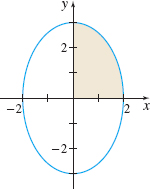EXAMPLE 5Finding the Area Enclosed by an Ellipse
Find the area A enclosed by the ellipse x24+y29=1.

Solution Figure 8 illustrates the ellipse. Since the ellipse is symmetric with respect to both the x-axis and the y-axis, the total area A of the ellipse is four times the shaded area in the first quadrant, where 0≤x≤2 and 0≤y≤3.
We begin by expressing y as a function of x. x24+y29=1y29=1−x24=4−x24y2=94(4−x2)y=32√4−x2y≥0
So, the area A of the ellipse is four times the area under the graph of y=32√4−x2, 0≤x≤2. That is, A=4∫2032√4−x2dx=6∫20√4−x2dx
Since the integrand contains a square root of the form √a2−x2 with a=2, we use the substitution x=2sinθ, −π2≤θ≤π2. Then dx=2cosθdθ. The new limits of integration are:
Then A=6∫20√4−x2dx=6∫π/20√4−4sin2θ⋅2cosθdθ=6∫π/202√1−sin2θ⋅2cosθdθ=24∫π/20√cos2θ⋅cosθdθ=↑cosθ≥024∫π/20cos2θdθ=↑cos2θ=1+cos(2θ)2242∫π/20[1+cos(2θ)]dθ=12[θ+12sin(2θ)]π/20=12(π2+0)=6π
The area of the ellipse is 6π square units.